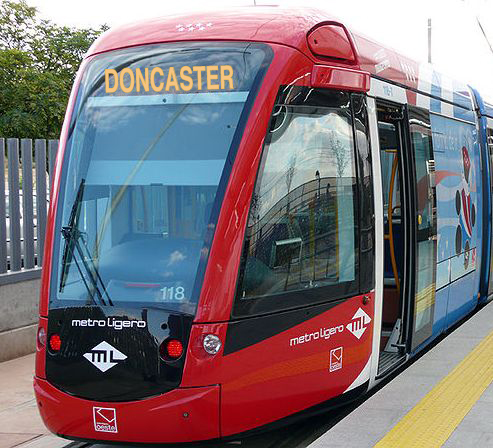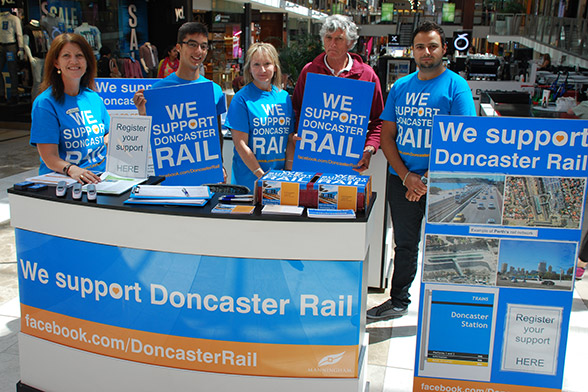Additional Doncaster Plans
Doncaster Rail Study (2014)
Archived files from the Doncaster Rail Study, as the website has now been conveniently (politically) shelved.
PTV Rail feasibility studies: The Doncaster Rail Study was an independent assessment of the requirements of constructing a heavy rail line to Doncaster.
The final Doncaster Rail Study Phase One Recommendations Report was released on 28 October 2014. Phase One of the Doncaster Rail Study was delivered through a partnership of four key engineering firms, led by URS, with a number of supporting sub-contractors.
Public Transport Users Association: Myth – We can’t have Doncaster trains because there’s no room for them
Fact: The tracks from Clifton Hill into the city operate separately from the rest of the network and by Melbourne operating standards can handle 24 trains an hour. This provides room for Doncaster trains every 10 minutes as well as an expansion of services to Hurstbridge and South Morang.
A train line heading north east to Doncaster and beyond was part of the 1969 Melbourne Transportation Plan. In the 1970s a corridor for it was reserved in the median of the Eastern Freeway, and remains in place as far as Bulleen. Originally this reserved corridor extended beyond the freeway and as far as Templestowe, but since the eastern section was sold off in the 1980s, any extension beyond Bulleen would most likely need to be in a tunnel.
Manningham Council: We Support Doncaster Rail
For many years Manningham Council has been advocating for some form of mass rail transport. Manningham is the only metropolitan municipality without a train or tram service.
In late 2010, the Victorian State Government appointed consultants URS to undertake a feasibility study for a heavy rail line to Doncaster.
Yarra Council: Doncaster Rail Study
In mid-2011, Yarra Council welcomed the State Government’s announcement of a $6.5 million study into establishing a rail link between Doncaster and the city.
Council has campaigned for years for the creation of a rail line to Doncaster as the only real, long-term way to ease traffic congestion in Hoddle Street and other Yarra streets.
Council believes the 600,000-plus people who live in the Doncaster region need a real choice about how they travel rather than leaving them dependent on cars which pollute and congest the Yarra community.
Victorian Transport Action Group (VTAG): Route 100 Light Rail – Doncaster to Inner City
The attached paper on a Doncaster light rail which continues along Alexandra Parade to Nicholson Street has been developed by Victorian Transport Action Group (VTAG), who are seeking feedback before finalising the paper. This paper can be distributed to others. Any comments should go to Mike Reece of VTAG via email: mikereece[AT]ozemail.com.au
A key issue is the absence of any public transport the full length of Alexandra Parade, despite this carrying 70,000 vehicles per day, and the underdeveloped land use along Alexandra Parade. However, would light rail if built, preclude building the Doncaster Rail Line?
What can I do?
- Write to politicians and the papers.
- Get involved with Yes to Doncaster Rail
- Contact Pt4me2.org.au – an initiative of the Metropolitan Transport Forum and tell them to promote the Doncaster Rail project.
- Join the Public Transport Users Association
8 thoughts on “History of the Doncaster Train”
Comments are closed.


http://www.ycat.org.au/?p=3504
Artist’s for Doncaster Rail
https://www.facebook.com/a4tnt
outline the sorry history of this project.
http://www.ycat.org.au/wp-content/uploads/2013/11/PressReleaseArtist-forTrains-not-tolls_22November2013.pdf
What is essential are separate solutions for commuters from commercial through traffic. While a tunnel is vital on a long-term basis for Melbourne’s commercial transport needs, it will do nothing to relieve the commuter congestion at Hoddle Street, and likewise a railway line would do nothing to help the cross city commercial traffic which is forced to use the freeway to nowhere. A major arterial which shrinks down to one lane going through Royal Park is scarcely a long term answer for a city whose existing cross city links are already clogged. The predominance of distribution centres and manufacturing industry in the eastern and western suburbs makes it inevitable that commercial cross city traffic flows will increase. A user pays tollway is obviously an equitable way of funding the necessary infrastructure, and it’s obvious that a railway to Doncaster is a pipedream .
To minimise community disruption and protest the tunnel should run from Hoddle Street through Flemington Road without exit ramps thus eliminating the need for access roads or fly-overs in public land. The existing Hoddle St entrance and exit ramps would remain unchanged.
To deal with the commuter issue for those wishing to reach the city, the obvious solution is to put a light rail/tram line along the western end of the Eastern Freeway from Bulleen Road, the line continuing on through the tunnel to Flemington Road with underground stops that would give access via escalators to the existing tram lines into the city; the No. 96 in Nicholson St, the No. 19 in Royal Parade and also the No. 55 service near the zoo.
To work effectively obviously there needs to be vastly more parking provided which could be most readily achieved by constructing parking/commercial buildings at strategic points along the Eastern Freeway so that commuters would know that there is parking available which they could reach with minimal traffic delays before switching to the light rail/tram system into the city. A side benefit would be to exploit the wasted space beside the freeway.
There are a number of reasons why the recently scrapping of Melbourne Metro and its replacement with a bluff for votes scheme called the Melbourne Rail Link stinks.
With the use of geodetic mapping and a basic rail engineering knowledge I was able to extrapolate a highly probable alignment if it was genuinely to be ever built. If restricted primarily to streets – for cut and cover construction and taking into account the required minimal radii for the rail alignment I’ve pin pointed the best possible / and likely location for the sub-surface Montague Stn. Various leaks more recently have indeed put its location centered on the Montague Street and the 109 LRT route in South Melbourne.
Alarmingly if this line is ever actually built and of course with the construction of the East West Road Link it may impact on any proposal for a Doncaster Rail Line and potential for it to be networked as a group with the proposed decoupling of the South Morang Line which would be rerouted via Flagstaff Gardens and Southern Cross Stn to the real Fisherman’s Bend Station to be located on Plummer Street. This is only the beginning of the problem as Southern Cross Station would become a major construction site once more to provision for the proposed sub-surface platform and it would be necessary for the Burnley Loop (pl 10) and the Caulfield Loop (pl 12) to be closed during the construction phase. Effectively all trains running via the City Loop from / to the Burnley and Caulfield Loop Lines – half of the entire Melbourne rail network would have to terminate at Flinders Street for the duration of construction of this new sub surface platform at Southern Cross Stn.
This could all be avoided in any future scenario for a Doncaster Hill / South Morang to Fishermans Bend Line (partially proposed by PTV) where its dedicated alignment would run from new underground platforms immediately north of and parallel to Flagstaff Stn and through new tunneling to additional sub-surface platforms at Southern Cross – beneath Wurundjeri Way. With Melbourne Metro this line of course would potentially have interchange at Parkville Station and additionally provision for a possible Doncaster Line. Sadly there has been little planning and vision from PTV to best advise the state government when consider such highly probable scenarios for the longer term development for new lines.
Therefore by scrapping Melbourne Metro and replacing it with a completely different scheme there are now arguments in place by government to abandon Doncaster Rail altogether. With this situation there are now better arguments in place by campaigners to fight for Doncaster Rail and Melbourne Metro.
What is surprising is that the Liberal State Government members never use public transport to and from Doncaster,and they lack the ability to think outside the square.
I implore them to travel on public transport from Melton station to Doncaster Shopping town.
This trip is taken with the minimum of fuss at any time outside peak weekdays.
The train is quicker from Melton to Spencer Street than driving the Freeway,especially if the train is a Melton Express.(a train that does not stop at the “ghost” stations of Rockbank Deer Park and Ardeer.)These stations are ghosts as no passengers use them and Vline call these Three EXTRA services.)
Having picked a Melton Express train and arrive at Spencer St,a tram takes you to the City centre where you catch the Doncaster bus in Lonsdale Street.
These are usually nearly empty during non peak times.
The bus is sometimes held up by City Traffic,This problem is easily solved by making more bus only lanes.
On time we arrive at Doncaster,relaxed.
To help our State Government think outside the square,here are obvious low cost ideas.Instead of building a Toll road and charging Motor Addicted drivers $20 to use a tunnel when it is built, why not charge them $10 now for using the Eastern Freeway.and into the City.London does this and have been praised for doing it.Buses are now able to move faster than when the Congestion charge was introduced.
If it works in super populated London .I am confident that it would work in Little old Melbourne.
Sean, you are right,The PTV are locked in the dinosaur age.
Their concept of a Hi speed train is a train that travels at 160kph and then stops for no passengers at Ardeer,Rockbank,and Deer Park.It then enters the new Regional Rail link Bridge at North Melbourne.
This bridge was designed to save passengers time by passing the third busiest peak hour station on the Geelong and Ballarat line.Due to the derailment of the XPT train in July the “Hi speed trains are restricted to 24 kph passing North Melbourne.Great PTV.
I would not trust the PTV to touch my model train set.
It is obvious with the Ballarat Line that the PTV members never had toy train sets.
If they did they would not delay trains by one hour,half and hour ,and fifteen as they did last week end.
Dermot,Laverton is Melbournes commercial hub with easy high speed access to Sydney,Brisbane Adelaide and Darwin and Perth.
The speed limit needs to be increased to 120 kph on all major interstate and regional routes for car and truck traffic.
This can be done Today as most interstate trucks and cars easily cruise at 120kph.This would lower the accident rate as fatique is the major cause of fatalities on our roads.
Coles and Woolies use the western freeway Greensbough freeway and all we need is a link from Ggeensbough to Eastern freeway.
Please Dermot no more car spaces.The PTV need to provide schuttle services to main stations and bike paths for people under 65.